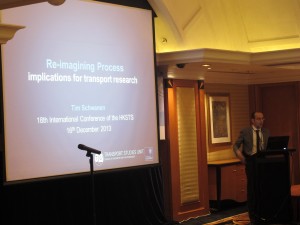Environmental and social justice in transportation refers to the fair treatment and meaningful involvement of all people in the planning, operation, and functioning of transportation infrastructure and services, irrespective of gender, class, race/ethnicity, age, dis/ability, sexuality, religion, and other markers of social identity. It includes, but cannot be reduced to, the distribution of benefits and costs of different transport infrastructures and services, and also relates to questions of governance, decision-making, and knowledge generation regarding transport systems and their environmental effects.
A large and diverse literature has examined and charted inequalities and inequities regarding transportation infrastructures and services. Less is known, however, about the effectiveness of remedial actions taken to improve environmental and social justice in transportation. Activists, grassroots communities, public authorities, academic researchers, and others might promote successful policies and interventions while advocating for their widespread adoption, or challenge unsuccessful ones and emphasize the need for further change. Careful, rigorous, and honest evaluations of remedial actions are critically important, if transportation systems are to become fairer and more sustainable.
This special issue of Transportation Research Part D aims to gather research that evaluates the effects of interventions that have been taken to improve environmental and social justice in transportation systems. We seek submissions from around the world and consider any mode, infrastructure, or service, including freight, maritime, and aviation. Papers may offer evaluations of remedial action in relation to, for instance:
- Attempts to improve public participation in sustainable transport policies
- Endeavours to increase epistemic justice in the planning, design, and assessment of interventions in transport systems
- Interdisciplinary theories and perspectives aiming to improve environmental and social injustices in transportation
- New methods of evaluating the efficacy of transport-related interventions among disadvantaged groups
- Initiatives to address unfulfilled mobility-related needs undertaken by activist and citizen-led organizations (e.g. cycling advocates and activists)
- Improvement of cycling and pedestrian infrastructures in underserved communities
- Reduction of noise and air pollution along heavy-traffic roads and close to ports, airports and other infrastructure hubs
- Road space reallocation away from privately owned or heavy- and light-goods vehicles
- Impact of free or reduced-fare public transport policy
- Redistribution of transportation funding away from road construction and expansion of ports, airports, and other hubs of carbon-intensive transportation
- Initiatives to make electric and shared mobility (e.g. MaaS) services available in disadvantaged communities or to owner-operators and SMEs in the freight sector
The special issue is edited by David Durán-Rodas (Technical University of Munich), Hannah Hook (Ghent University), Shaila Jamal (McMaster University), and myself.
Full papers are due by 30 March 2024. This issue will be a virtual special issue, meaning that accepted papers will appear in the next regular issue. After all papers are accepted, guest editors will compile a virtual issue on the journal website.
Manuscripts need to be submitted via the Transportation Research Part D (TRD) online submission system. Authors should indicate that the paper is submitted for consideration for publication in this special issue. When choosing Manuscript “Article Type” during the submission procedure, click “VSI: Eval Justice Initiatives”, otherwise your submission will be handled as a regular manuscript. Author Guidelines are available here.

